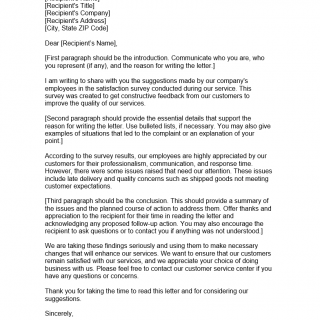Business letter
Business letter is a letter written in formal language, usually used when writing from one business organization to another, or for correspondence between such organizations and their customers, clients and other external parties. The overall style of letter will depend on the relationship between the parties concerned.
Writing for a business audience is usually quite different than writing in the humanities, social sciences, or other academic disciplines. Business writing strives to be crisp and succinct rather than evocative or creative; it stresses specificity and accuracy. This distinction does not make business writing superior or inferior to other styles. Rather, it reflects the unique purpose and considerations involved when writing in a business context.
When you write a business document, you must assume that your audience has limited time in which to read it and is likely to skim. Your readers have an interest in what you say insofar as it affects their working world. They want to know the "bottom line": the point you are making about a situation or problem and how they should respond.
Business writing varies from the conversational style often found in email messages to the more formal, legalistic style found in contracts. A style between these two extremes is appropriate for the majority of memos, emails, and letters. Writing that is too formal can alienate readers, and an attempt to be overly casual may come across as insincere or unprofessional. In business writing, as in all writing, you must know your audience.
In most cases, the business letter will be the first impression that you make on someone. Though business writing has become less formal over time, you should still take great care that your letter's content is clear and that you have proofread it carefully.
Business letters usually contain the following information:
- date of writing
- your e-mail
- the destination address
- message or greeting
- message (body of the message)
- сlosing
- signature, printed name and title of the sender
A good business letter is brief, straightforward, and polite. If possible, it should be limited to one single-spaced typewritten page. Because it is so brief, a business letter is often judged on small, but important, things: format, grammar, punctuation, openings and closings. A business letter is not the place to try out fancy fonts or experimental writing styles.
There are two main styles of business letters:
- Full block style: Align all elements on the left margin.
- Modified block style: Down the middle of the page, align the return address, date, closing, signature, and typed name; align other elements on the left page margin.
Below are the elements of a standard business letter and their functions:
Return Address: Your address (or the address of the company you represent). If you are using preprinted stationary, there is no need to retype the information.
Date: Leave two blank lines after the return address. Always spell out the month and include the day, a comma, and the year.
Inside Address: Leave two blank lines after the date. Then type the address of the person or company to whom you are writing.
Salutation: Type Dear, followed by the person's name. End the line with a colon. If you don’t know the name of the person, use a title instead (i.e., Dear Editor, Dear Madam).
Body: Align your message on the left margin. Skip a line before starting a new paragraph, but do not indent the paragraph's first line. Make sure that each paragraph is clear and concise.
Closing: Leave two lines of space after your last body paragraph, then use a conventional closing, followed by a comma (i.e., Sincerely, Sincerely Yours, Respectfully).
Signature: Your signature should appear below your closing. Unless you have established a personal relationship with the person you are writing, use both your first and last name.
Name and Position: Four lines after the closing, type your full name. Do not include a title (Mr. or Mrs.). If you are writing on behalf of an organization, type your title on the next line.
Abbreviations at the end of a letter: If you send a copy of a letter to someone other than the person addressed, use cc: and the person’s name. Use Enc. or Enclosure if you enclose something with the letter. If someone else types it, put the writer’s initials in capitals, then a slash and the typist’s initials in lowercase: MT/fjr. Just one abbreviation should appear on a line.

